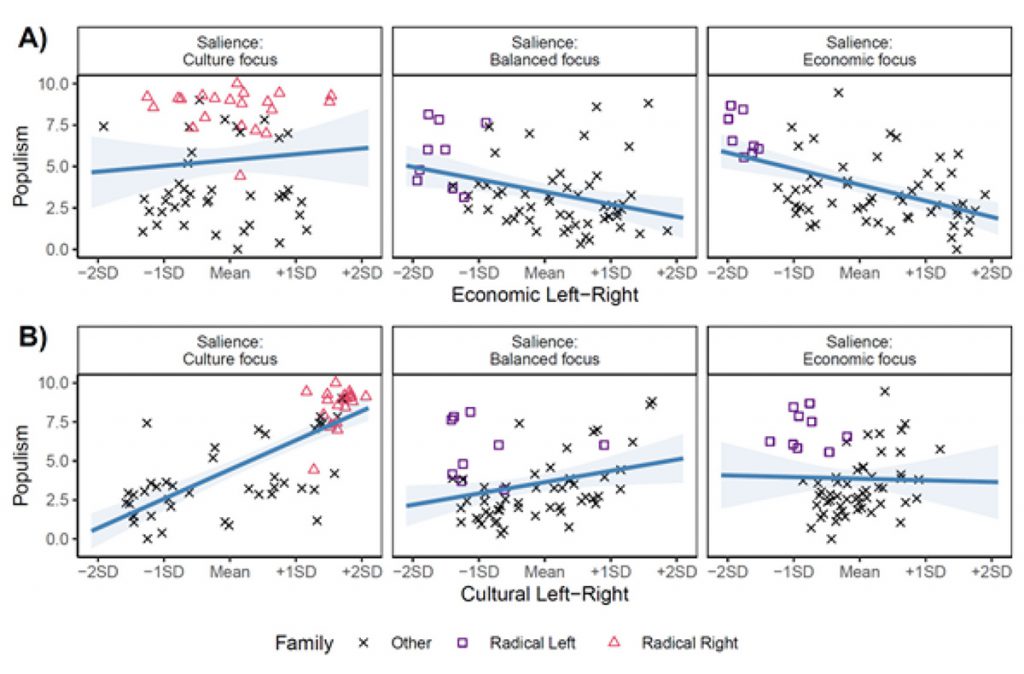Scholars tend to assume that populism is highest among parties with strong anti-immigration positions or Euroscepticism. But Robert A. Huber, Michael Jankowski and Christina-Marie Juen argue that it isn't the general left-right position of parties which affects their level of populism. Rather, collectivist positions on the parties’ salient issue dimension are crucial
As the opening blog in this series highlighted, some die-hard myths surround populism. Our post addresses one of them: the idea that populism is directly associated with specific policy positions. Populist parties are often connected to positions on the far right or left of the political spectrum. Most existing scholarship has determined the level of such parties' populism by analysing their positions on a general left-right spectrum. For example, scholars often find that ideologically centrist parties are less populist than parties on the fringes of a one-dimensional left-right spectrum. But that's not necessarily true.
Rather than positioning parties’ ideologies on a single dimension, many scholars argue for mapping party competition in a two-dimensional policy space in which positions on 'economic' and 'cultural' issues are separate. We agree. Our research argues that such a space, in combination with the issue salience of a party, offers a better understanding of a party's populism level.
We argue for mapping populism in a two-dimensional policy space in which positions and salience on 'economic' and 'cultural' issues are treated separately
Specifically, we argue that certain 'collectivist' ideologies allow parties to construct more easily homogenous identities ('the people') and an antagonist 'evil elite', which lie at the core of populism. Collectivist positions are mainly on the left economically (socialism / communism) and at the right end of the cultural dimension (nativism / nationalism / authoritarianism). In other words, populism becomes more prevalent on the economic dimension among left-wing parties and on the cultural dimension among right-wing parties.
Yet, this does not mean that combinations of certain positions on the economic and cultural dimension cancel each other out. Only when a party strongly emphasises the dimension in which it holds collectivist positions can we expect it to be populist. For example, we might expect a culturally right-wing party to be populist when culture is their salient issue, even if this party holds rather liberal views on the economic left-right dimension.
We tested this theoretical expectation in a recent paper. In it, we combine different data sources on parties’ degrees of populism, their ideological positions and saliences. Specifically, we rely on the POPPA Expert Survey for measuring populism, which covers all relevant parties from 28 European countries. It also contains measures for parties’ economic and cultural left-right positions.
We combine this data with the dimensional salience measures of the Chapel Hill Expert Survey. We classify parties as either 'economically focused', 'balanced', or 'culturally focused' depending on whether they put more emphasis on the economic or cultural dimension. Using this data, we run OLS regression analyses to predict parties’ level of populism conditional on their ideological positions and their respective salience.
The figure below visualises the results. The y-axis displays either the economic or cultural left-right position of parties. 'SD' stands for Standard Deviation and indicates how strongly a party’s position differs from the average position on this dimension. Thus, values of -2SD or +2SD on the x-axis indicate more radical positions on economic or cultural issues.
The y-axis indicates a party's populism level on a scale from 0 to 10, where 0 is the minimum and 10 maximum. Figure A displays the economic left-right dimension on the x-axis and each subplot is for parties with different salience focuses. Clearly, economic left-right positions are not predictive of a party’s level of populism when they focus on cultural issues. In contrast, for parties with a strong focus on economic issues, a negative relationship exists between economic left-right positions and populism.

Figure A also shows that the positions of radical-right parties on the economic left-right dimensions are quite heterogeneous. Some are rather left-wing on economic issues, while others are positioned very far to the right on this dimension. However, what all radical-right parties share is a focus on cultural rather than economic issues.
In Figure B, we replace the economic left-right positions with cultural left-right positions. We see that parties which are culturally more right-wing also tend to be more populist. This pronounced effect is driven by the cluster of radical-right parties with a strong cultural focus and radical positions on these issues. However, the relationship is still statistically significant when we exclude this group of parties from the analysis.
Our findings have important implications for the study of populism through the lens of party competition. We provide an integrated framework that allows scholars to analyse the degree of populism across the political spectrum. The combination of issue salience and positions offers important insights into populist parties. Specifically, it becomes clear that not all political positions are equally likely to combine well with populism. For example, it might be more challenging for mainstream parties to use populist rhetoric strategically. This is because their ideological orientation often emphasises a non-collectivist idea of society.
Mainstream parties might struggle to use populist rhetoric strategically because their ideology often emphasises a non-collectivist idea of society
Populist parties are often described as chamaeleonic. Our study allows scholars to understand this concept better. Populist parties tend to hold positions that defy left-right categorisation. Moreover, they are quick to change positions on issues unimportant to them. It is therefore no surprise that populist radical-right parties manage to appeal to working-class voters and to small business owners.
Provided they hold firm to their cultural positions, populist radical-right parties can thus get away with holding fuzzier positions on the economic dimension. Similarly, left-wing populist parties can afford to be either more traditional or more progressive in cultural terms, given that their core dimension is economic.